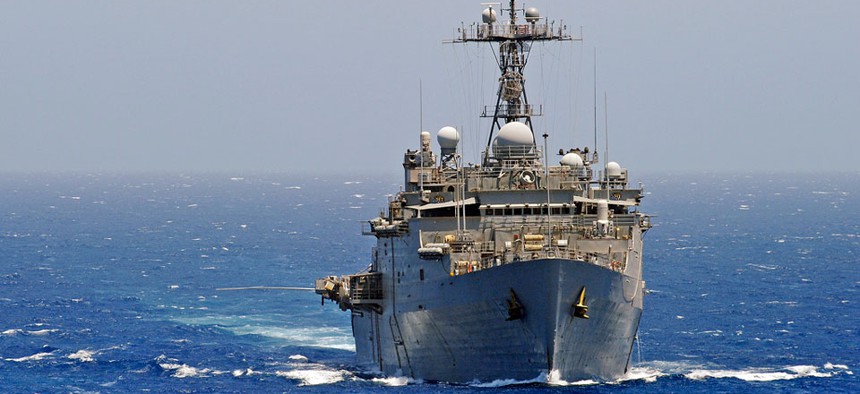This US Navy Ship Is Now Armed With a Drone-Killing Laser Beam

The amphibious transport dock ship USS Ponce (LPD 15) steams through the Red Sea. US Navy
Will the laser work in actual warfare? Nobody knows exactly.
The U.S. Navy now has a ship in the Persian gulf armed with a “laser gun.” That’s how the U.S. chief of naval operations described it, in passing, to a congressional hearing back in March.
The Laser Weapons System, as it’s officially called, has been mounted on the USS Ponce, which is a kind of floating helicopter pad designed to transport marines and equipment for amphibious assaults. A June story from Naval Technology.com describes the laser system like this:
The system comprises a single laser weapon control console manned by a surface warfare weapons officer on board the USS Ponce, who can operate all functions of the laser and, if commanded, fire the weapon. Using a video-game-like controller, that sailor will be able to manage the laser’s power to accomplish a range of effects against a threat, from disabling to complete destruction.
What what will this laser be disabling or destroying? In congressional testimony, navy officials consistently cite the laser’s potential usage against a swarm of fast boats attempting to overwhelm a navy vessel. (Perhaps the foremost practitioner of such tactics is the Iranian Revolutionary Guards Corps Navy [pdf].)
In June, Jane’s International Defense Review noted that the Laser Weapons System has been especially tested on counterdrone warfare. It destroyed “threat-representative” unmanned aerial vehicles first in testing at the naval weapons station in China Lake, California, in 2009.
A later test at San Nicholas Island, California in 2010 saw the laser system “successfully engage four threat-representative [unmanned aerial vehicles] in four attempts in ‘combat-representative’ scenarios at a range of about one nautical mile.” And in July 2012, after being temporarily installed on the guided missile destroyer USS Dewey, it “successfully shot down three threat-representative UAV targets.”
Will the laser work in actual warfare? Nobody knows exactly. Its placement aboard the USS Ponce allows for trials and experimentation using the weapon under the harsh, salty conditions of the gulf. Naval officials will also be assessing the weapon’s so-called “dwell.” That is, how long it must be focused on a target before having its intended effect. As a U.S. naval official said in congressional testimony back in March:
We’ve already demonstrated this particular, if you will, laser gun—laser weapons system. And what’s—the value of it is, it’s persistence. It costs under $1 for one round, if you will—laser round. We’ve already proven it against a drone and against a small craft. So the deal is, I want to get it out there and take a look at it and see, how does it perform in that sort of harsh environment. And then, we adjust.





